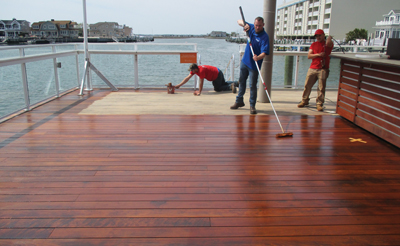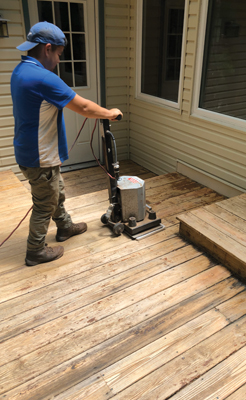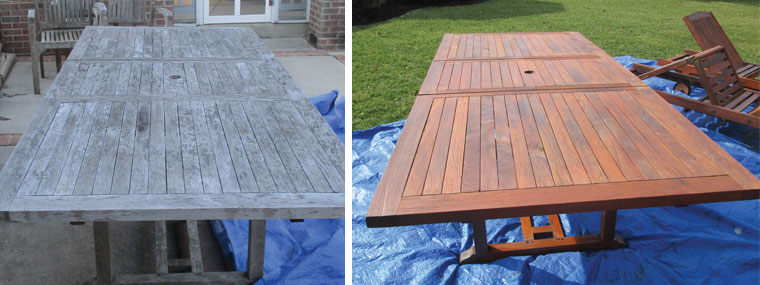
Wood Restoration
Decks, Fences, and More
By Terri Perrin and Everett Abrams Jr. / Published May 2022

Geographical Considerations
Wooden decks today have evolved from your standard 8×10-foot platforms to more elaborate and architecturally complex designs. Fences have also moved beyond simply providing privacy and containment for kids and pets. This “evolution of outdoor spaces” presents myriad opportunities for power washing contractors in the area of wood restoration.
Where you live may influence a certain concentration of wood and types/styles of structures. Redwood and teak decks are common in California and on the West Coast, while the South has a lot of wood fences. The East Coast is well known for some elaborate decks.
You’ll look like an expert when you have a wide knowledge of the types of softwoods, such as cedar, redwood, and pressure-treated pine; and hardwoods, including mahogany, teak, and ipe (pronounced “EE-pay”). The type of wood determines the techniques and products used in the wood restoration process.
With the COVID-19 pandemic (2020–2022), the demand for (and prices of) many softwoods skyrocketed. As a result, pine is now the “go-to” wood for decking. It is favored because of the price and because it is more insect resistant.
Environmental regulations are also constantly changing. Approximately 17 states now have restrictions on the use of exterior oil-based products, above and beyond any federal regulations. Be up to date on what products are available and permitted for use in your area.
Regardless of where you are located, understand that the point of wood restoration is to clean and then apply a sealer or stain to protect the wood as soon as possible after construction and/or restoration. The main thing to consider is that you do not want any product applied to the wood to freeze at night.
Pressure washing or exterior cleaning is one thing, but when we talk about “wood restoration,” you need to be well educated before you perform these services.
Typical Job Considerations
Step-By-Step Process to Restore Existing Wood Structures
Arrive at the job site and re-introduce yourself to the homeowner.
Answer questions and explain/review the process and your quote again.
Remove furniture from the deck (if this was part of your estimate).
Sand the deck rails and floor to remove any splinters. (You can’t sand a wet surface!) Dry sweep flat surfaces.
Cover plants, air conditioners, etc. to protect from overspray.
Do any necessary repairs—hammer down loose nails, tighten loose boards, and replace rotten boards. This pre-inspection and repair are for safety and to ensure that any replacement boards get the same treatment as the existing wood.
Remove grease stains caused by barbecues. Use a degreaser to clean prior to any other products.
Pretreat by applying the appropriate wood restoration products. Cleaning agents (with soft washing) that are too strong will cause the wood to become “fuzzy” and damage the wood. Use a scrub brush to periodically evaluate progress. When dirt and contaminants rub off easily, wash or rinse.
Pressure wash with smooth motions in the direction of the wood grain, with the wand tip 6- to 12-inches from the surface. Prevent stop and start marks by using a pendulum motion and work across. Do not stop or start with the wand on the wood.
Do not try to compensate for too short a cleaner dwell time by using more pressure. If the old finish and dirt do not wash off with a very low pressure, wait longer or apply more cleaning agent if necessary. Before you rinse, do a “scuff test” with a boot or a stiff bristle brush to see how easily the old finish comes off.
Rinse with the aid of a pressure washer at 1,000 psi or less, or use a spray nozzle on a garden hose. Warm water (120ºF) is best for most jobs.
Apply brightener/neutralizer and let sit for the recommended time. (See Proven Products below.)
Rinse, rinse, and rinse again. (Once the wood fiber is dry, chemicals are harder to remove.)
Rinse the surrounding area, including stone paths, siding, and windows that may have overspray.
Follow your product manufacturer’s recommendations on drying time before you apply stain or sealant.
Return to the property to do the staining. Cover all landscaping and parts of the house before you begin using any products.
Follow the manufacturer’s recommendations for all products. If using an oil-based product (where permitted), check the moisture level of wood using a moisture meter before applying. For softwoods it should be 15 percent or below, and for hardwoods, 20 percent or below.
Employ the best method to apply stain or sealer by using a four- to six-inch soft China bristle staining brush (made with hog hair) or a blend of China bristle and polyester. Other applicators, such as sprayers, may be used to save time and labor.
Apply stain starting with lattice or skirting, outside rails, then inside rails, floor, and steps. It is important to work from the bottom up. When you drip on an area that is already stained, stains and sealers will absorb themselves and not be prominent.
Back brush, whether using a brush or sprayer, to remove any drips or runs before the product is completely dry. In most cases a second coat is not required nor recommended. Once stained, the wood will not absorb the next coat and will, in fact, absorb mildew and look terrible within three months.
Advise the property owner to allow the deck stain to dry approximately 24-hours before walking on it and/or replacing furniture.
Proven Products and Techniques
All wood surfaces (with existing finishes or weathered) must be cleaned/stripped to prepare for sealant/staining. There is no single product that is 100 percent effective. Sanding is often necessary.
Stain that is in good condition might be an appropriate candidate for cleaning and applying a new coat, depending on product instructions and customer preference. In most cases—and always when the finish is peeling, flaking, or worn away—existing finishes should be stripped. There are several products that can be used.
A good paint/stain stripper will be composed of multiple chemicals to address today’s wide range of coatings. The days of using one chemical to remove a coating have passed. Caution: Never mix your own chemicals! Rely on safely prepared products from your distributor.
Sodium percarbonate (oxygenated bleach) is environmentally friendly. It penetrates and works below the surface of the wood to reach to the root of organic growth such as mildew, mold, algae, etc.

Sodium hypochlorite (bleach) reacts with the first thing it comes in contact with and is most effective on non-porous surfaces. Because wood is porous, sodium hypochlorite is better for maintenance than restoration. It is also not as effective in removing organic growth, may also affect the color of wood, and can possibly void the manufacturer’s warranty on composites.
Sodium hydroxide is the “go-to” for stripping. It is very effective on oil-based coatings. There are many different water-based products, as well as hybrid-type coatings, that sodium hydroxide is not as effective on.
Sodium metasilicate is a stronger cleaner or very light stripper. It’s very useful with decks that have been neglected and require stronger products.
Ethylene glycol monobutyl ether is a “boosting” additive to many strippers and helps make it easier to strip hard-to-remove coatings.
Solvent-based strippers are commonly used in log home wood restoration and can be very effective at removing coatings on decks with water-based stains.
Oxalic, phosphoric, or citric acids (or a manufacturer’s blend) are neutralizing agents that help brighten and restore balance to the pH of the wood to prepare it to accept the new protective coating.
Oxalic acid is quick acting and will remove iron and metal stains, giving you a very professional result.
Phosphoric acid is slow acting. It also removes iron and metal stains.
Citric acid is slow acting and will not remove iron or metal stains, but it is considered more environmentally friendly among the brighteners.
Paint is not recommended on decks because it is difficult to maintain, retains moisture, and promotes rot as well as flakes over time.
Exceptions
Remember, there is no one product that is perfect for every situation. Trying to find the right balance of a product that protects the wood and provides the appearance that a customer wants is the biggest challenge that we face.
Equipment
Sprayers: With proper chemicals, a deck can be successfully cleaned with a pump sprayer, scrub brush, and garden hose. There are three types of hand-held sprayers:
Pump-up sprayers put out a large droplet and can be used on slightly windy days but are limited to light-bodied coatings, typically sealers and some semi-transparents.
High-volume, low-pressure (HVLP) sprayers put out a medium droplet, and you need to be careful with them on a windy day.
Airless sprayers put out a fine mist and are not recommended on windy days. This is the most versatile and productive sprayer available to us.
Pressure washers: Professional contractors use pressure washers to increase speed and productivity, relying on machines in the four- to eight-gpm range. A consideration today is that outdoor living spaces involve more than just decks. Think about all surfaces when determining the gallons per minute needed to run equipment. If using water from a truck-mounted unit, you may run out of water if usage is too high.

Personal protective equipment (PPE): Regardless of the equipment you choose, a respirator mask and goggles or a face shield must be worn when using cleaning agents.
Nozzle tips and hose length: Most wood restoration contractors have 50 feet of hose (or more) and use multiple 40-degree tips with the aid of a nozzle chart to adjust the proper pounds per square inch (PSI). A 40-degree tip will clean one plank at a time without scarring the wood. By changing the tips, anything from a sealer to a solid stain or paint can be sprayed.
Pounds per square inch (PSI): Wood should be cleaned with pressure between 600 and 1000 psi. No matter the gallons per minute of your machine, using assorted size 40-degree tips and a nozzle chart will achieve the desired pounds per scare inch. It is recommended to stay a range of 6 to 12 inches (or more) from the substrate.
Additional tools: Full-service wood restoration requires contractors to carry hammers, drills, and sanding equipment. Larger deck restoration companies may have powered orbital sanders, floor buffing machines, Osborn or deferring brushes, pneumatic nail guns, and power drills. A leaf blower allows for removal of sawdust and sanding remnants.
Chemical cleaners can be applied with pump sprayers, powered agricultural sprayers, and diaphragm or air pumps, and with either a downstream injector or other injection
system built into the machine. Mix chemicals according to the type of injection system. Be aware that you may have to adjust your dilution rate, based on the equipment you are using.
Stain: Consult the product manufacturer for detailed stain application instructions. Methods for applying stain include airless spray guns, pump sprayers, and HVLP [high volume, low pressure] equipment. Rollers are no longer recommended because as the coating wears, lap marks from rollers become evident. Stain brushes or stain pads are needed for windy days and recessed areas. Brushes are also needed for cut-in around the house and siding and back brushing any drips or runs. Plastic and drop cloths are needed to mask off the adjacent house and cover flora.
Always have a plan B! Carry back-up equipment and sprayers as well as multiple chemicals in the event that you discover the first product you tried isn’t working effectively.
How To Bill
Never provide estimates over the phone, and always create a written estimate. Visit the site to determine the type of wood you are working with as well as the size of the project. Include all products/materials in the estimate rather than breaking them out as individual items. Hourly pricing estimates are not recommended. It is advantageous to develop a price list to cover every scenario. This makes you look more professional, and you will be more profitable. Use square footage as your base pricing, and add additional costs for items such as height and ladder work, decorative features, and other more time-consuming and labor-intensive obstacles.
Create a test kit with different cleaners, strippers, and brighteners and use it to determine the amount of time and effort needed to do the job and how much it will cost. Also, you can show potential customers the anticipated results.
Test the deck with various concentrations of stripper to determine the strength needed to remove the finish. If the stain appears to melt and becomes slippery, it is probably oil-based. Acrylic or water-based stains may require strong chemicals and longer dwell times to loosen them from wood. Schedule and adjust billing accordingly.
When measuring, your estimate needs to include railings, posts, stairs, and other areas. Measure the surface of the deck (i.e., 10×20-feet = 200 square feet) plus the railings (linear feet x height x two sides), and other structures.
Know the coverage of products before developing a rate per square foot. The general industry standard is 150 square feet per gallon, but always check the manufacturer’s recommendations for coverage.
 Ancillaries
Ancillaries
The wood restoration market is mostly identified as decks and
fences, but there are other opportunities such as wooden front doors and garage doors, log cabins, wood-sided homes, outdoor furniture, play structures, gazebos, arbors, etc.
Wooden fences can be great stand-alone projects, but more often a customer wants a deck cleaned, and the contractor will suggest the fence as an add-on as it can be cleaned and stained to match the deck.
Fencing can be a difficult sell to customers as it easily accounts for several thousand square feet of surface in an average yard. Cost for stain alone can be $1,500 to $3,000. To make the cost of fence restoration competitive, recommend that a customer get an estimate for a new fence, which will generally be about five times greater.
Problem Areas
Customers may inquire about wood surfaces not related to decks, such as window frames. These usually involve different processes and are best left to other specialists.
Some wood is beyond restoration. Recommend a rebuild and decline the restoration job.
A wood project is not complete without preservation to protect against rot, decay, termites, and the elements. Don’t skip this step.
Wood is a very sensitive product. Seek formal training or find a consultant before your first restoration project.
Avoiding Mistakes
Take specific “before” pictures of existing issues, problems, and damages prior to starting the job and “after” photos once the job is complete. These can be used for marketing and to help resolve potential problems.
A good rule is to “under promise and over deliver.”
To avoid liability and future problems with the customer, discuss issues before work begins. If discussed beforehand, it is an explanation. When discussed after the fact, it sounds like an excuse.
If the customer is home when the service is complete, walk around to view the area. If not able to meet the homeowner, a follow-up phone call or email within 24-hours is a good idea. If there is a concern/problem, it is easier to rectify when the product is still fresh.
Terri Perrin is a freelance writer and frequent contributor to Cleaner Times. She is based in Calgary, Alberta, Canada.
Everett Abrams Jr. is the president of Deck Restoration Plus, based in Shamong, NJ. He is known throughout the power washing industry as the “Wizard of Wood.” His specialties are exterior wood restoration, log home and wood siding cleaning, decks, and more. He also offers courses on exterior wood restoration as well as online training through his “Wizard of Wood” program.







